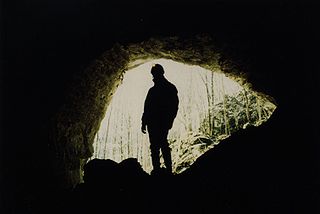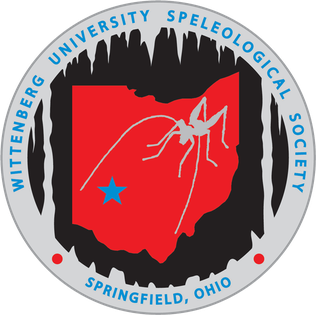Related Research Articles

Karst is a topography formed from the dissolution of soluble rocks such as limestone, dolomite, and gypsum. It is characterized by underground drainage systems with sinkholes and caves. It has also been documented for more weathering-resistant rocks, such as quartzite, given the right conditions. Subterranean drainage may limit surface water, with few to no rivers or lakes. However, in regions where the dissolved bedrock is covered or confined by one or more superimposed non-soluble rock strata, distinctive karst features may occur only at subsurface levels and can be totally missing above ground.

Speleology is the scientific study of caves and other karst features, as well as their make-up, structure, physical properties, history, life forms, and the processes by which they form (speleogenesis) and change over time (speleomorphology). The term speleology is also sometimes applied to the recreational activity of exploring caves, but this is more properly known as caving, potholing, or spelunking. Speleology and caving are often connected, as the physical skills required for in situ study are the same.

The National Speleological Society (NSS) is an organization formed in 1941 to advance the exploration, conservation, study, and understanding of caves in the United States. Originally headquartered in Washington D.C., its current offices are in Huntsville, Alabama. The organization engages in the research and scientific study, restoration, exploration, and protection of caves. It has more than 10,000 members in more than 250 grottos.
A Grotto is an internal organization of the National Speleological Society (NSS). They generally function as the local NSS chapter/club. Many Grottos however, operate in areas outside of their local area, with many operating in several states. Most Grottos also participate in Regions which are loose associations of Grottos. Regions are also an internal organization of the National Speleological Society.

Zacatón is a cenote belonging to the Zacatón system - a group of unusual karst features located in Aldama Municipality near the Sierra de Tamaulipas in the northeastern state of Tamaulipas, Mexico. It is the deepest known water-filled sinkhole in the world with a total depth of 339 meters (1,112 ft). The 392 meters (1,286 ft) deep Pozzo del Merro is deeper, but its nature as a near-vertical cave or a sinkhole still being debated.
Dr. Hazel A. Barton is an English born microbiologist, geologist and cave diving explorer, interested in extremophile microorganisms. She is a Professor and Director of the Integrated Bioscience Program at the University of Akron and has appeared in several documentaries.
Penelope J. Boston is a speleologist. She is associate director of the National Cave and Karst Research Institute in Carlsbad, New Mexico, and founder and director of the Cave and Karst Studies Program at New Mexico Institute of Mining and Technology in Socorro. Among her research interests are geomicrobiology of caves and mines, extraterrestrial speleogenesis, and space exploration and astrobiology generally.

Agnes Milowka was an Australian technical diver, underwater photographer, author, maritime archaeologist and cave explorer. She gained international recognition for penetrating deeper than previous explorers into cave systems across Australia and Florida, and as a public speaker and author on the subjects of diving and maritime archaeology. She died aged 29 while diving in a confined space.
International Union of Speleology is a scientific non-governmental organization dedicated to the international promotion and coordination of cave and karst research.

The Wittenberg University Speleological Society (WUSS) is a student-run grotto of the National Speleological Society (NSS) created in 1980, dedicated to the advancement of speleology. WUSS has more than 500 members, current and past students, faculty and staff of Wittenberg University, as well as community members dedicated to the scientific study, exploration, and preservation of caves and karst environments. The organization is based out of Wittenberg University in Springfield, Ohio.
Katrina Jane Edwards was a pioneering geomicrobiologist known for her studies of organisms living below the ocean floor, specifically exploring the interactions between the microbes and their geological surroundings, and how global processes were influenced by these interactions. She spearheaded the Center for Dark Energy Biosphere Investigation (C-DEBI) project at the University of Southern California, which is ongoing. Edwards also helped organize the deep biosphere research community by heading the Fe-Oxidizing Microbial Observatory Project on Loihi Seamount, and serving on several program steering committees involving ocean drilling. Edwards taught at the Woods Hole Oceanographic Institution (WHOI) and later became a professor at the University of Southern California.[1][2]
Barbara Sherwood Lollar, is a Canadian geologist and academic known for her research into billion-year-old water. She is currently a Professor in the Department of Earth Sciences at the University of Toronto. In 2007, she was made a Canada Research Chair in Isotope Geochemistry of the Earth and the Environment. It was renewed in 2014.
Marie Edmonds is a Professor of volcanology and geology in the Department of Earth Sciences at the University of Cambridge whose research focuses on the physics and chemistry of volcanic eruptions and magmatism and understanding volatile cycling in the solid Earth as mediated by plate tectonics. She is interested in the social and economic impacts of natural hazards; and the sustainable use of Earth's mineral and energy resources. Professor Edmonds is the Vice President and Ron Oxburgh Fellow in Earth Sciences at Queens' College, Cambridge; and the Deputy Head of Department and Director of Research at the Earth Sciences Department, University of Cambridge.

Dawn Yvonne Sumner is an American geologist, planetary scientist, and astrobiologist. She is a professor at the University of California, Davis. Sumner's research includes evaluating microbial communities in Antarctic lakes, exploration of Mars via the Curiosity rover, and characterization of microbial communities in the lab and from ancient geologic samples. She is an investigator on the NASA Mars Science Laboratory (MSL) and was Chair of the UC Davis Department of Earth & Planetary Sciences from 2014-2016. She is Fellow of the Geological Society of America.

Matthew D. Covington is an American speleologist, most known for his work in hydrogeology and geomorphology, especially in the field of mathematical modeling of karst systems, as well as by his contribution to Cueva Chevé project in Mexico, since 1999.

Nora Noffke is an American geologist who is a professor in the Department of Ocean and Earth Sciences, Old Dominion University in Norfolk, Virginia, USA. Noffke's research focuses on the sedimentology of biofilm forming sedimentary structures in modern aquatic environments, where clastic deposits dominate. Such structures occur in the fossil record as well. Her studies are interdisciplinary combining sedimentology with microbiology, geochemistry, and mineralogy.

Catherine Ann McCammon is a Canadian geoscientist who is employed by the University of Bayreuth. Her research focuses on surface and mantle processes, as well as the physics and chemistry of minerals. She is a Fellow of the European Association of Geochemistry and American Geophysical Union. In 2013, she was awarded the European Geosciences Union Robert Wilhelm Bunsen medal. She is the editor of the journal Physics and Chemistry of Minerals.
Patricia Kambesis is an American caver, cartographer and educator.
Diana E. Northup is an American microbiologist, speleologist, ecologist, Visiting Professor of Biology, and Professor Emerita of Library Sciences with the University of New Mexico. Her research focuses on the microbial ecology of caves around the world. Dr. Northup is a Fellow of the National Speleological Society and the Cave Research Foundation. She wrote the Wiley textbook Microbial Ecology. She was awarded the National Speleological Society Science Prize in 2013.
Friars Hole Cave System is a cave in West Virginia's Greenbrier and Pocahontas counties. First surveyed in the 1960s, it is one of the longest in the United States and the world.
References
- 1 2 3 4 5 6 "KWI Karst Award – Karst Waters Institute" . Retrieved 2021-07-04.
- ↑ Engel, Annette Summers (1997). The speleogenesis of Movile Cave, Southern Dobrogea, Romania (Thesis). OCLC 38158273.
- ↑ Engel, Annette Summers (1999). Geomicrobiology of sulfidic karst systems (Thesis). OCLC 43683838.
- 1 2 3 "Two Professors Named AAAS Fellows". News. 2019-11-26. Retrieved 2021-07-04.
- 1 2 "Professor Named to Same Society as First Man on the Moon". News. 2015-10-22. Retrieved 2021-07-04.
- 1 2 3 "Annette Summers Engel biography". annettesummersengel.com. Retrieved 2021-07-04.
- ↑ "Annette Summers Engel | Quest Research Magazine". 2013-10-04. Retrieved 2021-07-04.
- ↑ "ISEB Home". isebiogeochemistry.com. Retrieved 2021-07-04.
- ↑ "GSA Fellowship". www.geosociety.org. Retrieved 2021-07-04.
- ↑ "NSS Science Awardees". caves.org. Retrieved 2021-07-04.